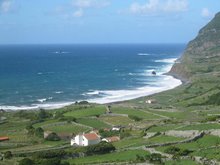Not on Flores, right enough, but on São Miguel where it grows in sort of tightly packed hedges which remind me a bit of massive green fish fingers:-
Picture Credit - Leslie Vella
The tea plants take advantage of the pristine environment of the Azores and the mild frost-free temperate climate. Which is obviously the problem because Azorean tea is rubbish.
We Brits are fussy about our tea. I'm not talking about the ceremony of "afternoon tea" accompanied by cucumber sandwiches and cakes which other nations imagine we all sit down to at the stroke of 4.00pm. This is now only found in Anglophiliac places abroad like British Columbia, Hong Kong and Madeira and even there it's more of a tourist attraction than anything else:-
That's a photo of the one and only time I've ever had afternoon tea - it was at Reid's in Madeira (one of the woodiest hotels in the world, founded by William Reid, a Scotsman, in 1891, now owned by the Orient Express Group and worth every single penny of its exorbitant prices).
No, I'm talking about a "cuppa" (the etymology is "cup of tea") consisting simply of a tea bag dropped into a mug of boiling water, left there for at least 10 minutes then with milk and sugar added to taste. This results in a brew you can stand a teaspoon upright in called "builders' tea" because it's the refreshment of preference on British construction sites.
Let's face it, Euros just can't do cuppas properly, can they, what with their noncey-poncey little tea bags with bits of string attached to them (what's that all about?) producing a weak and insipid gruel? Though it grieves me to say so, Azorean tea is just the same - risk assessment analysts' tea.
No, you can't send boys out to do a man's job which is why industrial quantities of Tetley Teabags are high on our list of things to bring back from our annual visits to Britain.
Made out of old coal sacks, Tetley teabags do not have strings. They are packed with the finest sweepings off a Chinese factory floor processing tea grown on closed landfill sites downwind of 1960s nuclear power stations handpicked by children with congenital birth defects paid 5p a day (if they pick 200kg). They used to be advertised on British TV with the slogan "Tetley make teabags, make tea" (which bit of that don't you understand?) voiced by a professional wrestler. And, bah goom, do they make a good cup of tea.
Spot the difference:-









3 comments:
I totally disagree with you, and i'll prove that your wrong.
I think tea preference may something imprinted in childhood. One of my Azorean-American uncles was married for several years to a woman who was born in England, then when she was a tot her family immigrated first to British Columbia, Canada, then some years later across the border to northern Washington state in the US. Not surprisingly, my aunt-by-marriage drank tea the English way, with milk and sugar.
When I was little my uncle and his wife lived just two blocks away from my household, so my family and theirs spent a fair amount of time together. Starting when I was maybe 6 or 7, whenever my mother and I went over there, my aunt would get out her best English bone china teapot, cups and saucers, and brew a big pot of loose black and orange pekoe tea (using a tea ball) for the three of us: no wimpy teabags for her!
She'd always pour my cup of tea first so it would be the weakest -- "cambric tea," my mother called it -- dosed up with lots of milk and sugar. I felt so-o-o-o grown-up getting to use real china (instead of the unbreakable plastic cups that most people serve children) that I'd always be very careful so as not to break or chip my aunt's lovely china. So despite having at most 1/8 Anglo blood in my ancestry, I drink tea the standard English way (albeit stronger nowadays) with milk (not cream) and sugar!
I made my first visit to the Azores as a tourist, so on my guided tour of São Miguel our group naturally stopped at the tea plantation in Maia so we could see the factory where the tea is raised and processed. While I was much impressed with the place, I confess I don't especially care for the flavor of their tea, and drink it only if there's no other option and I need to be polite. But given my druthers, I'd prefer a supermarket house brand, or a famous name-brand like Lipton, Tetley, Salada, Red Rose, etc.
"For All the Tea in China / How England Stole the World's Favorite Drink and Changed History" (book review by the WaPo's sublime garden columnist Adiran Higgins):
http://www.washingtonpost.com/wp-dyn/content/article/2010/03/26/AR2010032601989.html
Actually, it was Scotsman Robert Fortune, not an Englishman.
Post a Comment